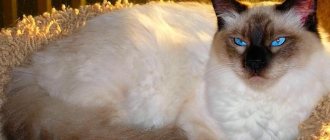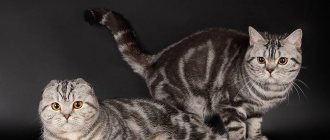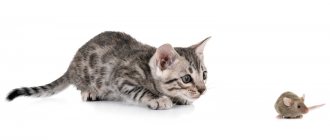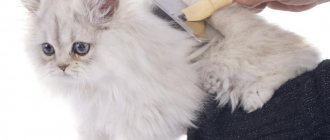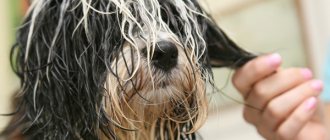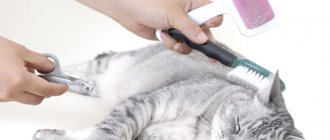Keeping a cat's fur in perfect condition is a troublesome task. Long, capricious fur can quickly become tangled and matted. Mats appear more often in those cats that periodically go outside. They are less common in domestic animals, but are also not excluded. This problem is not divided into breeds and species - every pet can develop tangles. To gently and effectively remove unsightly hairballs, any cat owner should have a cat hair cutter in their grooming arsenal. It is a hybrid of a comb and scissors and provides gentle and safe removal of tangles.
Why are mats dangerous in cats?
The formation of mats in cats is almost inevitable, even with proper care of the animal's fur. They can form in places where it is difficult to notice. Every owner should know that mats can be dangerous to a cat's health.
Even the smallest mat has the ability to grow and become larger. A large accumulation of matted fur prevents oxygen from reaching the skin. Pathogenic microorganisms settle in these places, disrupting blood flow and metabolism in the skin.
Also, in places where mats form, the cat does not have the opportunity to lick the fur, which means that dirt begins to accumulate there. The animal begins to actively itch, which can lead to claws getting stuck in the tangle and injury to the claw itself at its base.
When scratching the skin, dirt from claws and hair accumulation can get into the wound, which leads to inflammation and even blood poisoning in the cat.
If your animal has parasites, then if there are mats, it will be almost impossible to get rid of them.
Prevention of tangles
As experts say, it is better to prevent a problem than to get rid of it later. This is especially true for show animals, for which the removal of even small areas of fur is a complete disaster. In the fluffiest long-haired cats, after cutting, the hair is completely restored only after 4-5 months. In addition, after cutting, the guard hair may change color. Therefore, for all purebred show cats, the main rule of keeping is proper nutrition and high-quality regular care.
So, what is included in the concept of “regular care” and what does tangle prevention mean?
- Regular combing of the coat will allow you to promptly remove lost hairs and promote proper skin metabolism.
- Regular bathing of the animal using special shampoos and hygiene products will help keep the fur clean. Clean hairs without skin problems do not fall off or tangle, they shine and lie evenly over the entire surface of the body.
- A balanced diet and additional nutrients and vitamins will help maintain healthy skin and a beautiful coat.
- If it is not possible to buy an animal in a timely manner, you can use dry shampoo. In addition to maintaining cleanliness, it will help remove static tension and make the coat soft and shiny.
- Always use a hair dryer to dry the fur after bathing and comb the cat thoroughly with a special brush.
What is a webbing cutter?
A classic tangle cutter is similar to a comb, where instead of teeth there are blades, or to a vegetable peeler, where instead of one horizontal blade there are several protected vertical ones. At the same time, the blades are safe and difficult to injure the animal.
The length of the cutting parts varies: the longer the wool, the larger the teeth of the tangle cutter should be. Of course, on the shelves you can find tools of different manufacturers and prices. Since the price of tangle cutters is not the lowest, it is better to choose a good tool that will serve you for a long time.
Down with tangles!
Constantly maintaining your pet’s “hair” in perfect condition is not an easy task. This is especially true for long-haired cat breeds, for which seasonal shedding can turn into a real disaster. If during this period you do not make combing a daily procedure, then the dying undercoat will quickly and tightly bunch up into a solid felted ball, which will be almost impossible to untangle.
If you want a beautiful well-groomed cat, take care of its fur
During molting, tangles are most often formed - dense knots of varying sizes made from stray fur. However, tangles are by no means a purely seasonal problem; If not properly cared for, they can appear at any time. This is not only unaesthetic, but also creates risks for the health of the animal:
- tangles become a breeding ground for fleas;
- Diaper rash and dermatosis occur on the fur;
- Having licked the downed “felt”, the cat can clog its stomach.
Shaving a cat's head is a radical solution to the problem of mats
Types of tools
If lumps have already formed on your beloved cat’s fur, and a comb and hands do not help, it’s time to buy a mat cutter. When you go to pet stores, you can find on the shelves four dissimilar and completely different in shape tools. At the same time, they perform different functions, so for high-quality care for your pet you will have to purchase several types.
Horizontal
Externally, this tool looks like a vegetable peeler or a knife for cutting vegetables into small noodles. Its blades are sharp on one side and rounded on the other. This ensures safe contact with the cat's skin and does not injure it.
The horizontal model is the most universal: it is suitable for animals of different breeds and sizes. Even a beginner can easily cope with its use.
Vertical (side)
Similar to a classic comb with long straight or curved teeth. Hooks on the blades not only provide safety, but also perfectly pick up tangles from under the bottom, and cut them off much more efficiently.
This model is suitable for hard-to-reach places and for more professional use.
Electric
A specialized tool with one blade and a built-in motor. It is used to remove lumps from hard-to-reach places: ears, groin area, paws. The blade of the tool is protected by a plastic cover on the outside, which makes it safe to use. To use an electric hair cutter, it is advisable to have a certain skill - to at least once watch how a professional groomer handles it.
teardrop-shaped
This mat cutter is used for cats that have mats in hard-to-reach areas: ears, armpits, groin area or paws.
It has only one blade and is suitable for those animals that get stressed by the sight of grooming accessories. This type is convenient to use to remove small tangles without your pet noticing. However, if the owner is going to use it for the first time, he should be very careful - it is better to practice in an easily accessible area.
Horizontal webbing cutter
Felting of an animal's fur occurs in areas of friction where the hairs are softer. Along the perimeter of the spine, the hairs have a dense structure, the matting of which occurs very rarely. In most cases, this area of the pet’s body is the last to undergo the formation of ridges.
The fur on the belly and at the base of the paws has a slightly curled shape. This contributes to its rapid tangling, and subsequently the formation of tangles. The hair under the chin also falls off easily. It is a mistake to think that the animal does not suffer from what is happening. Tangled villi pull on neighboring ones, which leads to skin tension. This condition irritates the skin, the pet becomes lethargic, does not show interest in games, and does not respond to its name.
The fight against tangles in furry pets requires the calmness of the owner. You need to get used to the procedure from the moment a new family member arrives. At first, the handsome furry will resist, but with a little effort and patience, a trusting relationship will be formed between the animal and the person. This will help teach your pet all the intricacies of behavior in a new home.
We invite you to read: Poltava silver rabbit description of the breed
The easiest way is to not give them the opportunity to form. But if they have already appeared, you need to act quickly. Felting of wool occurs very quickly. With each movement, the tangle adds more and more neighboring hairs. Therefore, it is not recommended to postpone the fight against this disease.
It is impossible to comb with a regular comb. Trimming matted fur is dangerous and can easily damage the skin. It is necessary to cut with scissors with rounded edges, without pulling back the tangle itself. The safest option is to use a webbing cutter. This is a special device for safely removing clumps of stray hair. The device will not be able to damage the pet’s skin by carefully cutting off tufts of villi.
If a cat's fur falls off, this can lead to detrimental consequences:
- irritation. A constant pulling sensation on the skin will make your cat nervous. The animal will not be able to get rid of it on its own. As a result, lethargy will appear, the cat may refuse to eat and drink, which can lead to problems with the gastrointestinal tract and diseases of the genitourinary system;
- fungus and microorganisms. Wool matted into a ball does not allow air to pass through, takes a long time to dry, and retains dust and dirt, and the remains of feces. Parasites and fungus can grow inside the ball, which will lead to more complex hair problems;
- allergy. If you do not remove it in time, the mat can grow into the skin, which will lead to a violent reaction in the body;
- appearance. The matted fur looks terrible, has no shine, and hanging tangles interfere with movement.
If the cat is covered in tangles, you cannot do without contacting a veterinarian.
Removal of knocked down lumps must be done with caution. Any awkward movement will lead to injury to the pet. The timing of the procedure is also very important. The optimal period would be when the pet is sleeping or has just woken up.
- Complete immobilization. It is impossible for one person to perform the procedure. Complete fixation will help to carry out removal with minimal loss of time and effort. Small pellets can be combed out with a comb.
- Degree of damage. If the lump has grown into the skin, it must be cut off as close to the skin as possible. This must be done very carefully so as not to damage the skin. Small swaths can be combed out with a comb or a cat tangle cutter can be used.
- Subsequence. You need to start removing from the largest one, moving gradually to smaller ones. In case of severe damage, a visit to the veterinarian is necessary. You can try removing lumps using a machine. But you need to understand that the noise of the machine will scare the cat. In case of complete defeat, you cannot do without anesthesia.
The fight against tangles is not as difficult as it seems. Long-haired pets find it difficult to care for their fur on their own. To prevent the appearance of the disease, it is necessary to constantly comb out the hair and use special products in the form of shampoos and balms that help the villi to be separated from each other and not get tangled.
Getting rid of formed tangles at home, without anesthesia, can greatly frighten the animal. Regular brushing and, at the first manifestations of the disease, the use of a spine cutter will help avoid problems with your pet’s health.
A mat cutter for cats is a device that allows you to remove densely matted pet hair in cases where a regular brush can no longer cope. Every owner of a long-haired cat must have such a device, because the device helps to quickly and safely put the pet’s fur in order, even in the most advanced cases.
We invite you to read: What types of worms do cats have, are they transmitted to humans, and what diseases do they cause?
For areas such as the groin area, ears and paws, a teardrop cutter is ideal. This specific tool has one blade, and its shape allows you to quickly and unnoticed by the animal to remove tangles in the most inaccessible places.
There are a huge number of hair cutters for cats on the market. From expensive, long-established brands to budget brands, among which there are quite decent instruments, the quality of which is not inferior to the popular ones. What should you pay attention to and how to choose a hair cutter for cats?
1. Number of teeth. With regular care of your pet's fur, mats rarely form. In this case, you can take a closer look at hair cutters for cats with a small number of teeth. However, if your pet likes to walk on its own, then it is better to purchase a tool with the most frequent blades.
2. Length of teeth. The medium length is universal and is suitable for cats with both long and short hair. However, if the tangles are already large, then you should think about buying a tool with long teeth.
3. Blade material. It is very important to pay attention to the metal from which the cutter is made. Unfortunately, it is impossible to sharpen the device yourself, so you need to choose a tool whose blades are made of high-quality steel. This type of tangle cutter will last a long time.
4. The handle of the tool is also important. It should be rubberized and fit comfortably in your hand.
When purchasing a tool, you should pay attention to the integrity of the packaging. If there is any doubt about the sterility of the device, it must be treated with boiling water.
To remove mats from cats located in hard-to-reach and sensitive places, such as armpits, groin, ears, a teardrop-shaped mat cutter is used, which is a small plastic tool with one sharp tooth for separating part of the mat and a blade for cutting off this part.
Before using a comb to remove mats from cats, you must carefully study the instructions included with the mat cutter, and perhaps watch a video. Before starting work, you need to sort the wool with your hands and separate healthy hairs from the tangle, and then very carefully, so as not to injure the animal, comb out the tangle, cutting it into pieces with the blades of a tangle cutter.
A mat is a lump of wool that has become tangled, matted and worn out. Old tangles resemble felt, the wool becomes so tightly matted. It would seem that a cosmetic and aesthetic problem, in fact, has serious negative consequences. Most often, a cat with mats experiences constant pain due to tension in the fur.
It is not for nothing that wild and stray animals have short hair and well-developed down. Short hairs will not get tangled, which means the animal will be able to hunt and survive without discomfort when moving. Unfortunately, the wandering of domestic decorative cats is no longer a rarity. Once-pets end up on the streets, street cats give birth to kittens from “furry daddies” who were let out to “walk,” babies from unsterilized pets end up in landfills and bus stops, as unnecessary.
Pets with access to the outdoors need to regularly remove tangles, especially in the fall, when all plants drop seeds, many of which are very tenacious. Twigs, pieces of earth, dust, moisture from getting wet in the rain - these are just some of the “street factors” that harm the fur of decorative cat breeds.
We suggest you read: Why does a hamster have red eyes?
Naturally, methods of struggle depend on the degree of neglect. If you tend to help street animals, sooner or later you will meet an animal against whose fur brushes, shampoos and scissors are powerless. A veterinarian or a hair clipper will help. Aesthetics are not particularly important, start cutting from any suitable area and remove all tangled hair. Yes, the cat will turn out bald or completely bald, but happy.
Drastic methods are applicable to feral cats or cats with mats in the groin area. In the case of “moderate neglect”, you will have to fight with dense hairballs on the sides, tail, neck, armpits and under the lower jaw. A pet trained to combing has a chance to keep its coat, however, you will have to try. You will need:
- Comb-tangle cutter for cats.
- Scissors, preferably sharp and with rounded ends.
Further, nothing military, each tangle requires an individual approach. Your task is to make several vertical cuts in the mat relative to the cat’s body, “disassemble” the clumps as much as possible with your fingers and separate the matted hair from the growing one. In reality, everything is more complicated than in theory. The cat will most likely be in pain, the whole procedure takes a lot of time and it is unlikely that the pet will be able to endure complete cleansing of mats in one go.
In the case when the tangles are “fresh”, all the work will be reduced to the use of a tangle cutter and a brush with long teeth. As experience shows, many owners who are faced with the need to choose the right tangle cutter for the first time are stupefied. Accessories differ in type, length of teeth, and materials of manufacture, while the price of a webbing cutter, most often, does not suffer from modesty.
How not to make mistakes when buying
The hair cutter must be very carefully selected to suit the parameters of your animal. The required number of teeth will depend on the size of the cat, and the length of the blades will depend on the length of the fur. Of course, it is ideal to have at least two different tangle cutters in your groomer's bag - a large one for fur and a special one for hard-to-reach places. This set will allow you to provide your cat with complete and almost professional care at home.
When purchasing, you should pay special attention to the quality of materials and ergonomics of the tool:
- the handle of the tool is rubberized, non-slip;
- the handle of the tangle cutter fits comfortably in the hand;
- blades are made of high quality steel;
- the blades do not bend too easily;
- the cutting part is quite sharp;
- Pay special attention to where the handle is attached.
Poor-quality shape and materials of the handle will cause inconvenience in using the tool, and bad blades can harm the cat. Blades that are not sharp enough will tear the fur rather than cut it, causing pain to the animal.
Tool type
Based on user reviews, we can say for sure that the horizontal webbing cutter is the most versatile. It is suitable for all breeds and all coat lengths. But such a device costs a little more than a standard side chain cutter.
Other types are designed for specific areas of the animal’s body: the stomach, places behind the ears, armpits and groin, the lower part of the paws, their folds, etc. Such tangle cutters are suitable for show animals.
An electric hair cutter is an excellent device for those who keep several long-haired cats or do grooming. It is not advisable to purchase such a tool for the sake of one short-haired individual.
Size and number of teeth
Vertical webbing cutters have from four to twelve blades. The largest tool is designed for dogs of especially large breeds, and for cats a tool with an average of 4-9 blades is suitable. If you have not used such a device before, then take a knot cutter not with straight teeth, but with rounded teeth - they are safer.
The length of the teeth must be calculated based on the length and thickness of the pet’s fur. The longer the hair, the more teeth. Arm yourself with a photo of your cat and go to a pet store or veterinary pharmacy - a consultant will definitely help you with your choice.
Why do tangles appear?
The main reason for its appearance is insufficient care. If the animal is not combed and bathed in time, dense ridges will inevitably appear. Most often they occur in long-haired pets, less often in short-haired ones.
What are tangles
Tangles are formed due to the fact that dead hairs get tangled in healthy ones and bunch up into a “roller”. Cats usually collect loose hairs with their tongue. But if the fur coat is lush, the pets cannot fully take care of themselves.
Most often, tangles appear in fold areas - where there is a lot of undercoat and little guard hair. They appear in the groin, on the stomach, under the neck, on the inside of the paws.
Often, dandruff appears along with the formations. It further aggravates the problem as it glues the hairs together.
Where do mats come from in cats?
In addition to improper care, lumps can be caused by:
- malnutrition – feeding from the table or low quality feed;
- parasites;
- skin pathologies – allergic dermatitis, eczema;
- heavy shedding - especially the first spring in kittens;
- stress;
- avitaminosis;
- contamination – dust, sticky substances (oil, syrup), feces.
Why are tangles dangerous?
Mostly, owners worry about mats in their pets because their fur becomes less beautiful. But they also threaten:
- skin health - they complicate metabolic processes in the cells of the epidermis, which leads to the development of dermatitis, inflammation, eczema, ulcers;
- risk of infection - microbes and bacteria actively multiply in clumps of rollers;
- infestation with parasites - fleas or ticks willingly settle in matted fur;
- injuries - cats often try to get rid of tangles themselves and inadvertently scratch or bite the skin.
When and how to use a cat hair cutter
To prevent the fur from rolling into clumps, it is necessary to pay special attention to combing during the molting period - in autumn and spring. At this time, it is worth combing the undercoat more often and not allowing fluff to accumulate and thicken. It is recommended to use a furminator - a device for better removal of fallen hairs.
Procedure for removing tangles
In order for an adult cat to accept any hygiene procedures with pleasure, it must be taught to do so from a very early age. Over time, the pet understands that the procedure is safe for him and is easy to comb.
Basic tips to make it easier for your cat to deal with the removal of mats:
- do not proceed to the procedure immediately after the cat has eaten or actively played;
- do not try to comb an aggressive animal;
- It is desirable that the cat is relaxed, calm or half asleep;
- It will be better if the combing is performed by the family member whom the cat trusts most.
Before removing the tangle, try to untangle it by hand - sometimes this works. This way the wool is least susceptible to damage. If the manual method does not help, you need to take up the tangle cutter:
- Place your cat on a hard, stable surface so she feels safe.
- Work only on dry fur: do not bathe the cat or wet the mats before the procedure;
- It is important that the owner conveys absolute calm to the cat.
- It is useful to treat the fur with a special powder for easy combing - cat cosmetics are sold in pet stores.
- Removal movements should be smooth and soft - do not pull the fur or cause pain to the animal.
- Move from the base to the tip of the hair.
- Do not apply pressure, do not use force.
- If there are too many tangles, divide the procedure into several short sessions.
Manufacturers often include instructions with the tools on how to use the tangle cutter, although this is intuitive. The procedure itself is not much different from regular combing. It is necessary to start moving in the direction of hair growth. Under no circumstances should you use the tool in the opposite or transverse direction. The teeth should go strictly from the roots of the hairs to the tips.
For effective removal, it is worth alternating combing movements over and under the tangle. You need to try to insert the cloves between the lump and the skin and cut through the wool in this place, gradually separating the tangle.
When not to use a webbing cutter
A mat cutter is a tool for removing problematic hairballs, and it should only be used when a comb and other accessories cannot cope with the problem. It is not suitable for normal daily grooming as it can damage its structure with sharp blades.
If the owner has insufficient experience in using this accessory, it can damage the thin and delicate skin of his pet. Therefore, a tangle cutter cannot be used without prior preparation, at least morally.
There are no special contraindications to the use of a tangle cutter, but it is worth considering the general health of the pet. There should be no lesions or other injuries on his skin, as well as visible symptoms of diseases.
Method of use
A hair cutter for cats requires some skill. It may take some time to get the hang of using the tool quickly and easily. If the owner fails to completely remove the mat the first time, then the procedure must be interrupted for a short period of time and repeated again. Also, a break will be useful for the animal, since the procedure is not pleasant.
To effectively carry out the manipulation, you can use the following recommendations:
- The animal must be calm. The procedure should not be carried out during the game or immediately after eating. At the same time, the pet should not be hungry.
- It is necessary to place the pet on a hard surface without foreign objects, and hold it well.
- It is advisable that the procedure be carried out by a person in whom the cat has the maximum trust.
- If your pet does not like to comb its hair, then it is better to fix it well. To do this, you can ask someone close to you for help.
- Special sprays that soften hairballs will help speed up the process of removing tangles.
The actual removal of tangles is carried out by running a tangle cutter in the problem area along the hair growth. In this case, the sharp edge of the instrument should “look” at the person.
Note. Typically, the handle of the tangle cutter is made in such a way that it will be uncomfortable to hold if you have the wrong grip.
Movements must be performed smoothly and carefully, without strong pressure. The procedure is carried out until the stray hairball is completely eliminated.
The tangle cutter is used only on the problem area; it is not suitable for daily combing.
Hair cutter for cats: video
How to care for a mat cutter
A cat hair cutter, like any tool, requires special care. Before use, the blades must be disinfected with an alcohol-containing liquid or boiling water. This must be done carefully so as not to have such a harsh impact on the material from which the body is made. This is usually plastic and can be melted by hot water.
After the procedure, the tangle cutter is cleaned of any remaining wool and put into a case, where it is stored until the next use.
There are several reasons why a cat's fur gets matted.
- Pet's health status. First of all, an animal stops caring for its fur if it is sick or unwell. Inflammatory processes in the oral cavity, a weakened state by the disease, and the postoperative period lead to apathy in the cat, and it stops licking its fur. Skin diseases and the presence of external parasites (fleas, lice, lice) also contribute to the development of mats.
- Nutrition. An unbalanced diet can lead to the development of mats. Lack of vitamins and microelements in a pet's diet adversely affects the condition of the coat.
- Animal care. Often the cause of the formation of matted hairballs is improper care of the fur when washing the cat. The use of detergents not intended for animals, their incorrect choice without observing breed characteristics, and violation of the rules for bathing long-haired cats lead to matting and the formation of lumps.
- External factors. When adhesive and polluting substances (oil, fuels and lubricants, blood, feces, oil, sweets) come into contact with an animal’s fur, the hairs stick together and tangles form. A cat cannot remove such contaminants on their own.
What to do if a cat has mats is the main question of a caring owner. If the cause of their formation is an animal disease, parasites, the pet should be shown to a veterinarian. If the reason for the formation of hairballs is mechanical in nature, you can remove the mats yourself. This must be done, because fur matted in clumps is not only an aesthetic problem, but can be dangerous to the health of the animal.
Mats lead to the development of diaper rash and dermatitis. Hairballs quickly become dirty and become a favorable environment for the development of pathogenic bacteria. Various parasites develop in unkempt fur. The tangles cause discomfort to the cat and, trying to get rid of them, the animal often injures the skin, which is fraught with inflammation.
How to remove tangles
What to do if your cat has mats? They must be removed immediately upon discovery. Check the abdominal area around the paws, armpits and neck more often. Hairballs appear there first due to the animal's movements.
If the tangles have appeared recently, you can untangle them with your hands. Each lump is separated by hairs; you can simply stir it with your fingers. Then walk with a comb or a special brush from the back to the stomach and paws - from top to bottom.
If it is impossible to comb the tangles, they are cut off
This must be done very carefully. First, the lump is cut with a knife or scissors, but so as not to damage the skin.
Then you need to slowly untangle the fur with your hands and comb it out. This method will help preserve as much of your luxurious fur coat as possible.
When a cat has tangles, you can use a special device - a tangle cutter. This is a comb with sharp blades. Using a mat cutter helps to significantly reduce damage to an animal's coat.
However, fur that has matted into large clumps can only be removed with a haircut or in a grooming salon. For the procedure, scissors with not very sharp tips or a machine with a nozzle of 2 mm are used.
When removing mats, the animal must be held firmly. The skin should be taut when cutting. The head, tail and paws are cut separately.
The procedure for removing mats can be carried out several times, otherwise the cat will experience severe stress and depression will begin. You cannot buy an animal until all lumps have been removed. After cutting, an antistatic agent is used. This will help prevent new tangles from appearing.
Not all owners can cope with lumps that fit tightly to the animal’s skin. It is better not to risk your pet’s health and take it to a veterinary clinic. After removing the tangles, doctors will recommend care products and give other recommendations.
How to cut out a hairball correctly
When the need to cut off lumps arises, the question arises; how to remove small tangles from a domestic cat without accidentally injuring it. Firstly, the animal must be fixed, secondly, use sharp scissors with blunt edges, and thirdly, cut along the formation, and then carefully, step by step, cut it from the fur.
Sometimes it is recommended to use an anti-matt spray for cats, reviews of which are very favorable and positive. It is especially necessary for animals with “cotton” hair, like Persians and Angoras. With its help, you can quickly and painlessly remove tangles.
